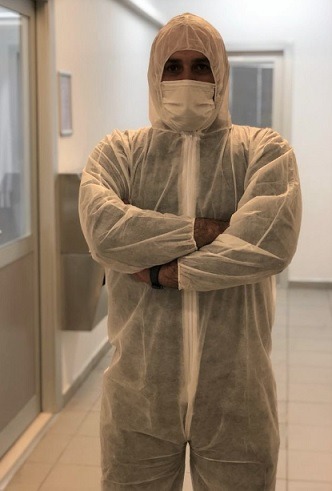
Protective Clothing / Surgical Gown Performance Test
Protective Clothes used to prevent the transmission of bacteria and viruses to people are subjected to testing to ensure the quality standards specified in international norms.
“Fesc Laboratories Group” makes performance tests according to EN 14126 standards in clothes suitable for Protective Clothes.
ISO 16603 - Permeability to Synthetic Blood : The resistance of a protective clothing material to penetration by blood and body fluids is determined by subjecting the material to synthetic blood as a body fluid simulant for a specified time and pressure sequence and observing if visible penetration of the liquid occurs. In the penetration test apparatus, the clothing material acts as a partition separating the body fluid simulant from the viewing side of the test cell. Any evidence of synthetic blood penetration constitutes failure. Results are reported as “pass/fail”.
ISO 16604 - Permeability to Bacteria : A specimen is subjected to a nutrient broth containing a virus in a test apparatus for a specified time and pressure sequence. Visual detection of penetration is supplemented with an assay procedure that will detect viable viruses which penetrate the material even when liquid penetration is not visible. Any evidence of viral penetration for a test specimen constitutes failure. This test method requires a working knowledge of basic microbiological techniques.
ISO 22610 - Wet Bacterial Penetration : A sheet of donor material, of the same size as the test specimen and carrying the bacteria, is placed on the test specimen with the contaminated side facing down and covered by a sheet of HDPE cover film. Two conical metal rings, close-fitting into each other, hold the three sheets together. The assemblage of materials is placed on an agar plate with the steel rings hanging freely outside the brim, applying a tensile force. An abrasion-resistant finger is placed on top of the materials with a specified force to bring the test specimen into contact with the agar surface. The finger is moved over the entire surface of the plate in less than 15 min by means of a pivoted lever moved by an eccentric cam. The assemblage of materials, stretched by the weight of the steel rings, ensures that only a small area of the test specimen is brought into contact with the agar surface at any given time. Due to the combined effect of rubbing and liquid migration up from the agar surface, bacteria may pass from the donor material through the test specimen down to the agar surface.
The results are expressed as a percentage (%) of penetration compared to the bacterial load initially inoculated on the donor.
ISO 22612 - Dry Bacteria Penetration : The test is carried out on test pieces each fixed in a container. In every container except one a portion of talc contaminated with bacteria is poured on the test piece. One container is left uncontaminated as a control. A sedimentation plate is inserted at the base of each container at a short distance below the test piece.
The apparatus supporting the containers is then vibrated by a pneumatic ball vibrator. The talc that penetrates is captured on the sedimentation plate. The sedimentation plates are removed and incubated. The numbers of colonies produced are counted.
ISO 11737-1 - Microbial Load : It specifies the requirements regarding the counting and microbial characterization of the viable microorganism population. Determination of microbial pollution on protective clothing is based on the detection of bacteria extracted from protective clothing by necessary extraction methods.








